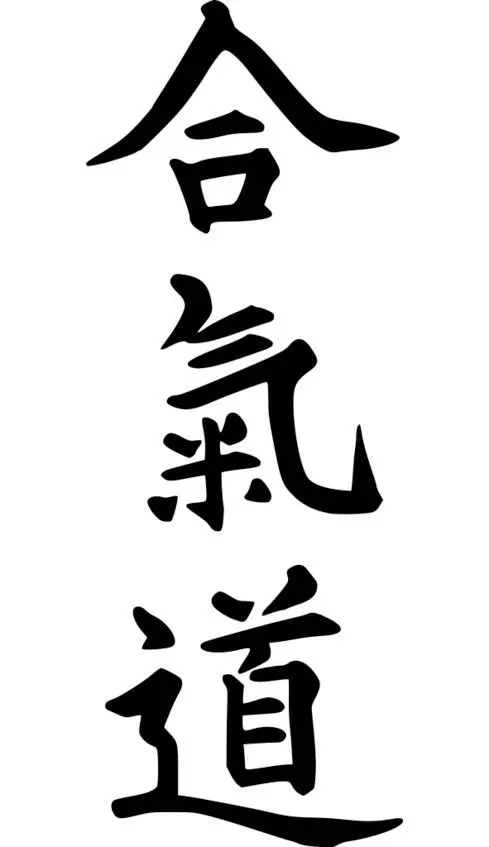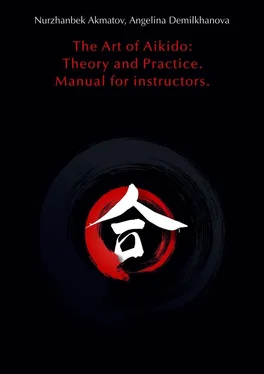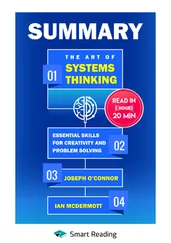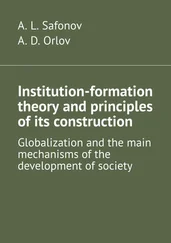The Art of Aikido: Theory and Practice
Manual for instructors
Angelina Demilkhanova
Nurzhanbek Akmatov
Translator Gulizat Bekmurzaeva
Cover designer Tatiana Mihnevich
Editor Oksana Denisova
© Angelina Demilkhanova, 2020
© Nurzhanbek Akmatov, 2020
© Gulizat Bekmurzaeva, translation, 2020
© Tatiana Mihnevich, cover design, 2020
ISBN 978-5-0051-7144-3
Created with Ridero smart publishing system
AIKIDO: THEORY AND PRACTISE
Nurzhanbek Akmatov
Angelina Demilkhanova
translated into english by Gulizat Bekmurzaeva
When a person walks along the Samurai Path, he should not look for other ideals. The same goes for the Path itself. Therefore, it is wrong to study the Way of Confucius or the Way of Buddha and say that this is the Way of the Samurai. If a person understands this, he will listen to sermons about other Ways, but at the same time, more and more will learn his own.
Yamamoto Tsunetomo (Book One)
PSYCHOLOGICAL ASPECTS OF AIKIDO. introduction
One acquaintance asked me: «What do you feel when practicing aikido?» And I replied: «I feel spontaneity, creativity, freedom. I feel that I am a person, a living real person»

The main difference between sporting activity and martial arts roots in the principles – fundamental principles of life. Inasmuch that the martial art – is a science of life, which has a centuries-long history.
Any martial art is based on the fact that it has several components – physical exercises (kata, techniques, muscle development, reaction speed, training of attention, etc.), the psychological component – to know yourself, and then learn to control yourself (achieved by physical training, practicing with partners or a sparring system, breathing exercises, various forms of meditative techniques, etc.), and the spiritual component, which is based on understanding of the very essence of a human nature, his existence in his own world, the world with other people and the world of surrounding nature (this component is mainly based on the philosophical principles of the foundation of martial arts, which, depending on the country and continent, may be represented by Zen Buddhism, Buddhism, Confucianism, Taoism, Hinduism, etc.).
When creating aikido, the founder Morihei Ueshiba focused on harmonizing the spirit and merging with vital energy («Ki», «Chi» or «Qi» in the Chinese tradition). In this regard, great importance in aikido is given to working with Ki energy, breathing, the ability to control not only your body and yourself, use the energy of its movements against it, but also to complete the technique so as not to harm your opponent (partner).
«Genuine martial art should have nothing to do with either brute physical force, which is necessary only to overthrow the enemy, and even more than with any deadly weapon that lead the world to destruction. Genuine martial art is called upon by avoiding a fierce struggle to regulate universal Ki, preserving peace, and allowing everything to grow and develop in nature. Thus, exercises in any form of martial arts should not be a goal in itself for the destruction of the enemy, but, on the contrary, should develop a sense of love and respect for others.» 1 1 A. Dolin, G. Popov. Kempo – martial arts tradition. М., 1992, pp. 320—321
Angelina Demilkhanova.
chapter 1. theoretical aspects of aikido
From the history of aikido
After a period of feudal disunity and civil wars between different principalities, known as the Sengoku Jidai Period («The Age of Warring Provinces»), Japan was reunited into a single state. At this time, the arts of wrestling (bugei), initially aimed at defeat and destruction on the battlefield, switched to the Path of martial arts (budo), aimed at improving the person’s personality through connecting mind, body and spirit. From the beginning of the 17th century, martial arts began to transform into «Paths» of martial arts, which, in fact, were similar to the Way of the Tea Ceremony, the Way of Versification, the Way of Calligraphy, the Way of Buddha and countless other Ways, which in their pure form constitute the basis of the spiritual development of the Japanese people and are closely related to Zen Buddhism.
Under the influence of Buddhist concepts the martial arts transformed from the simple combination of techniques into philosophical «paths». Their areas of application improved from the simple goal to kill the enemy into the combination of elements related to everyday life. In other words, the paths of murder were replaced by the paths of life 2 2 Aikido by Gozo Shioda. – М., 2004, p. 15
.

Religion in Japan is represented mainly by Buddhism and Shintoism. It is believed that Zen Buddhism, which came from China at the end of the 12th century, is becoming the most influential school of Buddhism in Japan. It was with Zen Buddhism that a radical rethinking of the martial arts of the East was associated as one of the ways of a person’s spiritual development. It was peaceful Zen (from Japanese; Skt.– dhyana – «contemplation», Chinese- chan, corean. – sleep, vietnamese. thiền thien) that managed in its conceptual approach to solve the most complex moral problems associated with the violent nature of hostilities.
There are some of the most attractive moments for the followers of practical Zen in martial arts. Firstly, Zen meditation (as well as yogic methods of psycho regulation) is passively contemplative in nature. At the same time, Zen declares the universality of its principles, the possibility to experience satori (Jap. – satori; Sanskr. sambodhi – «enlightenment») in any act of everyday life. In martial arts an activity is expressed in the most concentrated form. Mastering this field allowed Zen to create a kind of an active form of yoga, opening the way to master the practical spheres of human activity. Secondly, traditional practice of Zen required not a simple intellectual perfection, but unity of spirit and body. Strict discipline and the need for perfect mastery of the body and martial arts fighting techniques were a matter of life and death, which opened up maximum opportunities for Zen in this regard. In addition, regular and organized physical activity helped to relieve stress arising from exhausting «psychological experiences», and prevented the emergence of mental disorders called «Zen disease». Third, and perhaps most importantly, the practice of martial arts was extremely far from routine, and thus particularly prone to transition of consciousness in those states to which Zen aspired.
The requirements to consciousness in «Zen types of art» have a peculiar continuation in the characteristics of tactical and technical features of certain species. They are united by the principle of flexibility common to the Far Eastern culture. It has found physical embodiment in light, flexible and very strong armament of Japanese samurai and is reflected in the so-called «bamboo commandments». Aikido brings the «principles of bamboo» to their quintessence. As a tumbleweed is carried away in the wind, ahead of any object rushing towards it, master aikido does not destroy the inertia of the attack, but allows it to «get out of control until it is completely self-destructible». He doesn’t punish the enemy, but forces them to see for themselves that they’re helpless. (Note that everywhere the Master acts spontaneously and unconsciously, like a bamboo that naturally restores the disturbed balance).
Читать дальше














